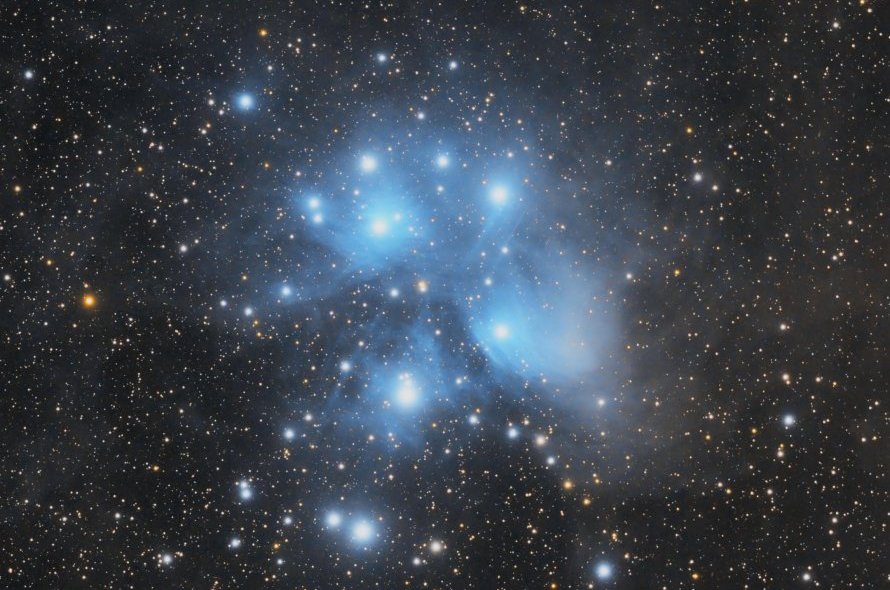M45 (Cr 42) - Pleiades
Messier 45 (Cr 42), also known as the Pleiades, is an open cluster located in the constellation Taurus, in the Orion Arm of the Milky Way Galaxy in the Local Group of galaxies. M45 is 444 light years away from Earth.
M45 is best viewed during winter, is magnitude 1.6, and can be viewed with naked eye. M45 is 110' in apparent size. For reference, the full moon is 30'.
Observing difficulty: Easy
- Name:
- Pleiades
- Alt name:
- Seven Sisters
- Type:
- open cluster
- Constellation:
- Taurus
- NGC or IC:
- Cr 42
- Magnitude:
- 1.6
- Viewing:
- naked eye
- Size:
- 110'
- Distance (light years):
- 444 LY
- RA:
- 3h 47.0m
- Dec:
- 24 07'
- Season:
- winter
- Milky Way location:
- Orion Arm
- Galaxy group:
- Local Group
- Messier Marathon #:
- 11
- Contains:
- Maia Nebula, Merope Nebula
* The naked eye can see up to magnitude ~7-8 objects under ideal dark sky conditions.
An In-Depth Look at The Pleiades Star Cluster
Messier 45, more commonly known as the Pleiades or Seven Sisters, is one of the most distinctive and easily recognizable objects in the night sky. It is an open star cluster located in the constellation Taurus. This article offers a comprehensive review of the Pleiades' historical significance, physical characteristics, astronomical importance, and how to locate and view this stunning star cluster.
Historical Background
Known since antiquity and mentioned in various ancient texts and myths, the Pleiades have captivated human attention for millennia. The Greek name "Pleiades" refers to the Seven Sisters of Greek mythology: daughters of the Titan Atlas and the sea-nymph Pleione. The cluster was catalogued by Charles Messier in 1769 as M45, included in his list of non-cometary objects to assist comet hunters.
Physical Characteristics and Magnitude
The Pleiades cluster is one of the closest star clusters to Earth, located approximately 444 light-years away. It's a relatively young cluster, with an estimated age of only about 100 million years. The cluster spans 2 degrees across the sky, equivalent to approximately 4 times the apparent diameter of the full Moon, which corresponds to a spatial extent of about 13 light years.
M45 is made up of over 1,000 confirmed members, but the cluster is most famous for its seven brightest stars, which are blue giants. These bright stars have magnitudes between 2.9 and 5.5 and are easily visible to the naked eye. The total magnitude of the Pleiades is around 1.6, making it one of the most luminous objects in the night sky.
Astronomical Importance
The Pleiades are of particular interest to astronomers as a case study in stellar evolution. Being a young star cluster, the Pleiades are home to many hot, bright stars that have not yet moved off the main sequence, which means they are still in the phase of fusing hydrogen into helium in their cores. Studying these stars and their distribution can provide valuable information about the early stages of stellar life.
Finding and Observing M45
Locating the Pleiades in the night sky is relatively easy due to their brightness and distinctive dipper-like pattern. They are located in the constellation Taurus and are most visible during the winter months in the Northern Hemisphere. Look for a tight, compact grouping of stars almost directly overhead in the late evening. You can use the well-known constellation Orion as a guide; draw an imaginary line through Orion's belt, and it will point to the Pleiades.
Viewing the Pleiades can be an awe-inspiring experience, especially through a pair of binoculars or a small telescope, which can reveal many more stars than are visible to the naked eye. A wide-field view will show the cluster in its best light, revealing the surrounding nebulosity and allowing you to fully appreciate the cluster's dipper-like shape.



